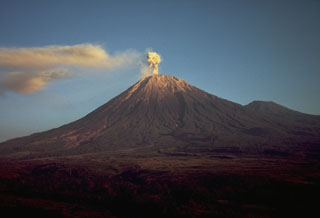Report on Semeru (Indonesia) — 15 December-21 December 2021
Smithsonian Institution / US Geological Survey
Weekly Volcanic Activity Report, 15 December-21 December 2021
Managing Editor: Sally Sennert.
Please cite this report as:
Global Volcanism Program, 2021. Report on Semeru (Indonesia) (Sennert, S, ed.). Weekly Volcanic Activity Report, 15 December-21 December 2021. Smithsonian Institution and US Geological Survey.
Semeru
Indonesia
8.108°S, 112.922°E; summit elev. 3657 m
All times are local (unless otherwise noted)
PVMBG reported that the eruption at Semeru continued during 14-21 December. Incandescent lava avalanches from the end of a 1.8-km-long lava flow in the Kobokan drainage on the SE flank descended 200-800 m during 14-15 December. Crater incandescence was visible overnight during 15-16 December and two incandescent avalanches traveled 500 m from the crater. On 16 December three pyroclastic flows, recorded at 0901, 0930, and 1542, traveled a maximum of 4.5 km down the SE flank. At 2300 PVMBG raised the Alert Level to 3 (on a scale of 1-4), noting increasing distances of pyroclastic flows and expanded the exclusion zone to a 5 km radius around the crater and 13 km in the SSE sector. The public was warned to stay at least 500 m away from Kobokan drainages within 17 km of the summit, and other drainages originating on Semeru including the Bang, Kembar, and Sat, due to lahar, avalanche, and pyroclastic flow hazards.
Two pyroclastic flows descended 500 m during 17-18 December and ash plumes rose 200 m and drifted SW. At 0556 on 20 December an eruptive event produced an ash plume that rose 1.5 km above the crater rim. One pyroclastic flow traveled 3 km SE that day and another one the next day. The crater was incandescent overnight during 20-21 December when weather permitted visual observations. According to BNPB, 11,658 people were in 52 evacuation centers by 14 December.
Geological Summary. Semeru, the highest volcano on Java, and one of its most active, lies at the southern end of a volcanic massif extending north to the Tengger caldera. The steep-sided volcano, also referred to as Mahameru (Great Mountain), rises above coastal plains to the south. Gunung Semeru was constructed south of the overlapping Ajek-ajek and Jambangan calderas. A line of lake-filled maars was constructed along a N-S trend cutting through the summit, and cinder cones and lava domes occupy the eastern and NE flanks. Summit topography is complicated by the shifting of craters from NW to SE. Frequent 19th and 20th century eruptions were dominated by small-to-moderate explosions from the summit crater, with occasional lava flows and larger explosive eruptions accompanied by pyroclastic flows that have reached the lower flanks of the volcano.
Sources: Pusat Vulkanologi dan Mitigasi Bencana Geologi (PVMBG, also known as CVGHM), Badan Nacional Penanggulangan Bencana (BNPB)

